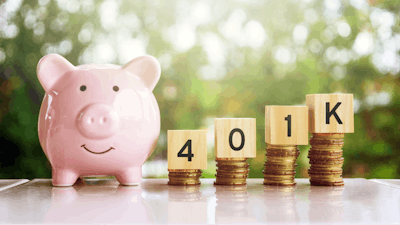
Any 401(k) can help you save for retirement. A great 401(k) allows you to save a whole lot more.
The difference between a mediocre plan and a great one could translate into tens of thousands of dollars in future retirement money. Plus, a 401(k)'s quality can show how serious a company is about attracting and retaining good workers.
That's not to say you should leave or turn down a job if it doesn't offer a great 401(k). But knowing how to spot a best-in-class retirement plan can help you evaluate job offers, negotiate a raise to compensate for what you're missing and perhaps encourage your employer to make its plan better.
Here are three features of great 401(k)s.
A GREAT 401(K) DOESN'T MAKE YOU WAIT TO START SAVING
A good 401(k) comes with a company match, plenty of low-cost investment options and low fees. A great 401(k) doesn't make you wait to take advantage of those features.
Many plans now allow participants to begin contributions immediately, with no waiting period. Others have waiting periods of one to six months. Some require people to wait a full year — the maximum allowed under federal law — and that delay can be expensive for workers.
Let's say you're 25, earning $50,000 a year and able to contribute 10% of your pay. The $5,000 you can't contribute the first year, plus a typical $1,500 match you wouldn't earn, could mean about $106,000 less in your retirement account by the time you're 65, assuming 7% average annual returns.
If you change jobs in the future – as you almost certainly will – every waiting period you encounter could compound the damage.
A GREAT 401(K) LETS YOU KEEP THE MATCH
Plans offer a number of different matching formulas , with some of the most common being 50% of the first 6% of earnings and 100% of the first 3% to 6% of pay.
The more generous the match, the better for participants — to a point. Many plans have long vesting periods for employer contributions. You might not have a right to any matching funds until you've worked for the company for three years, for example. After you hit the three-year mark, you would own 100% of any match you've earned and 100% of any future matches.
Another common approach is a six-year "graded" vesting schedule. You might have to work two years before you get 20% of the match. You would get another 20% after each year of service until you were 100% invested in past and future matches after year six.
But long vesting periods have come under fire because of their negative impact on today's more mobile workers . A 2016 report by the U.S. Government Accountability Office found if a worker left two jobs before vesting, at ages 20 and 40, the matches they forfeit could be worth $81,743 at retirement.
A growing number of plans give employees immediate ownership of matching funds — 44.2% in 2021, up from 38.5% in 2017, according to Hattie Greenan, director of research and communications for the Plan Sponsor Council of America.
You're always 100% vested in your own contributions, but it's important to understand any restrictions imposed on your employer's contributions — and perhaps push for shorter vesting periods.
A GREAT 401(K) GIVES YOU MORE WAYS TO SAVE
Most plans today offer a Roth 401(k) option that allows participants to put away money that won't be taxed in retirement.
Contributions to a regular, pre-tax 401(k) give you an upfront tax break, but withdrawals are taxed as income . Contributions to a Roth 401(k) don't reduce your current tax bill, but withdrawals in retirement are tax-free. Financial planners often suggest clients have money in both pre-tax and tax-free accounts to better manage their tax bill in retirement.
The IRS limits pre-tax and Roth 401(k) contributions to $20,500 in 2022 for people under 50 and $27,000 for people 50 and older. But total contributions — by participants and their employers — can be up to $61,000 for people under 50 or $67,500 for those 50 and older, if the plan allows it.
Some plans offer the option to make additional, after-tax contributions, which can help you stuff a whole lot more money into your retirement plan.
Let's say you're under 50 and max out your pre-tax contributions. Your company contributes a $6,000 match, for a total of $26,500. If your plan allows, you could contribute as much as $34,500 to the after-tax option to meet the combined employer and participant contribution allowance.
Money in after-tax accounts can grow tax-deferred, which is a nice perk, but some plans offer something even better: "in plan" conversions that let you quickly move the money into Roth accounts, minimizing the potential tax bill. This combination of after-tax contributions followed by conversions is known as a "mega backdoor Roth ," and it can be mega-helpful in piling up future tax-free funds.






















